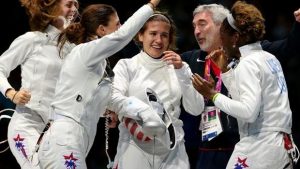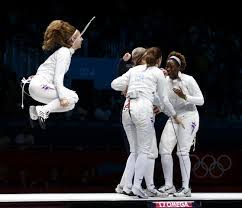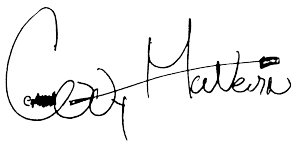We use cookies
Using our site means you agree to the use of cookies and similar technologies. Read about our policy and how to disable them here
Do Not Read This Article on Strip Coaching Fencing
 Team Relay Edition
Team Relay Edition
 Pardon the interruption for a verbose warning that you, most likely, will ignore.
Today’s warning will focus on why Not Reading about coaching concepts for the Team Relay Fencing Bout. If you are a fan of fencing, and watch team bouts you have probably seen a team bout and scratched your head when you looked at the scoreboard and the team with the lead was not the team you predicted based on the individual player talent level or initial seeding.
If you are like many Americans or you follow politics you love a good drama and watching this talented team lose to an upstart group can be entertaining. Watching them melt down and implode turning on each other, yelling back and forth from the bench might even cause your facial muscles to curl to a sly grin as you enjoy the guilty pleasure of watching them squirm.
You might even then forget about the coffee run you were on and stay to watch on as the rushed attempts of each fencer to personally Superman the score back in the talented team's direction fail, followed by the “I am too sexy to fence these noobs” body language emerges. Meanwhile the benched teammates have their heads in their hands or are looking around the room as if they just saw a bird flying around, desperately avoiding making eye contact with their teammate out of embarrassment and disbelief. At this point you giggle out loud like a poor college student at last call carefully stacking a food pyramid on his undersized plate on five dollar all you can each sushi night!
“Cody” you ask, “why again should i stop reading this article?” Right! Assuming you are friends, teammate, family members or a coach of this talented team the tips i am about to gift wrap for you with overly descriptive analogies to force your brain into visualizing the situations and examples from my personal career as an athlete and coach, will likely deprive you, and others of the entertainment of a good old-fashion, dramatic flop. The excitement of an amazing upset would be lost to those cheering on the underdog team as the talented team boldly pushes forward with their simplistic strategy that fencing team relay bouts is exactly the same as individual matches. The world would not see collective, thought out effort, planning, and communication defeat gifted, successful, unfocused talent.
Than again I suppose that if you are coming from the other side of this story and you revel at the idea of said drama and shocking and awe amazing upset wins than you might want to read on. Since that is not the name of this article and would defeat the purpose of this warning, I will refuse to think that is your motivation and consider my warning complete. At this point we can agree that i, at most, wasted about five minutes of your time and you can stop reading now and count yourself lucky that i did not waste any more of your day! Agreed! Good!
Pardon the interruption for a verbose warning that you, most likely, will ignore.
Today’s warning will focus on why Not Reading about coaching concepts for the Team Relay Fencing Bout. If you are a fan of fencing, and watch team bouts you have probably seen a team bout and scratched your head when you looked at the scoreboard and the team with the lead was not the team you predicted based on the individual player talent level or initial seeding.
If you are like many Americans or you follow politics you love a good drama and watching this talented team lose to an upstart group can be entertaining. Watching them melt down and implode turning on each other, yelling back and forth from the bench might even cause your facial muscles to curl to a sly grin as you enjoy the guilty pleasure of watching them squirm.
You might even then forget about the coffee run you were on and stay to watch on as the rushed attempts of each fencer to personally Superman the score back in the talented team's direction fail, followed by the “I am too sexy to fence these noobs” body language emerges. Meanwhile the benched teammates have their heads in their hands or are looking around the room as if they just saw a bird flying around, desperately avoiding making eye contact with their teammate out of embarrassment and disbelief. At this point you giggle out loud like a poor college student at last call carefully stacking a food pyramid on his undersized plate on five dollar all you can each sushi night!
“Cody” you ask, “why again should i stop reading this article?” Right! Assuming you are friends, teammate, family members or a coach of this talented team the tips i am about to gift wrap for you with overly descriptive analogies to force your brain into visualizing the situations and examples from my personal career as an athlete and coach, will likely deprive you, and others of the entertainment of a good old-fashion, dramatic flop. The excitement of an amazing upset would be lost to those cheering on the underdog team as the talented team boldly pushes forward with their simplistic strategy that fencing team relay bouts is exactly the same as individual matches. The world would not see collective, thought out effort, planning, and communication defeat gifted, successful, unfocused talent.
Than again I suppose that if you are coming from the other side of this story and you revel at the idea of said drama and shocking and awe amazing upset wins than you might want to read on. Since that is not the name of this article and would defeat the purpose of this warning, I will refuse to think that is your motivation and consider my warning complete. At this point we can agree that i, at most, wasted about five minutes of your time and you can stop reading now and count yourself lucky that i did not waste any more of your day! Agreed! Good!
 If you’re still reading this article you probably also would have touched the edges of this sign too! You probably also did not read the final line of the sign stating that the bridge was out and after applying a bandage to your finger from touching the sign drove off the end of the bridge. Seriously some people just do not follow instructions. At this point I can presume that since I am shifting gears and telling you what you SHOULD do that you will do the opposite or your so darn stubborn you will read on just to spite me. So be it!
Remember now we are discussing what you SHOULD do!
If you’re still reading this article you probably also would have touched the edges of this sign too! You probably also did not read the final line of the sign stating that the bridge was out and after applying a bandage to your finger from touching the sign drove off the end of the bridge. Seriously some people just do not follow instructions. At this point I can presume that since I am shifting gears and telling you what you SHOULD do that you will do the opposite or your so darn stubborn you will read on just to spite me. So be it!
Remember now we are discussing what you SHOULD do!
 Before team bouts the ONE VOICE rule needs to be discussed. Only one individual at any given match will provide tactical concepts, changes, advise. At this point you clarify that EVERYONE is encouraged to be loud, positive, and encouraging of the team, but that all such cheerleading must avoid containing tactical advice. Everyone should agree that tactical advice is only for the one designated as “THE VOICE” to shout out. For myself I often have multiple team, and individual events going on during a large event and have to walk in and out of team bouts during very busy or full fencing days. My teams know that when I am present I am “THE VOICE” during bouts and the previous one giving tactical advice will yield to me on this matter. Often if I enter in the middle of a match I will advise the current “VOICE” of what i see and what I would say and have them continue for the sake of not having to change who the athlete is listening for. The fencer has likely calibrated their ears listen only for the sound of “THE VOICE” and is filtering out to a great extent most other voices and noise as well they should. If as the coach I step away I will have designated the next in line as “THE VOICE” or will let them work it out among themselves. Normally my team captain is “THE VOICE” though when they are fencing they cannot provide their own advice so it is advised to have preset or remind your teammates to pick which of their teammates should be “THE VOICE” if there is a preference.
Now that you have established your ONE VOICE rule of coaching your team, that person is advised to follow the three guiding principles of strip coaching we discussed in the previous article I pleaded with you NOT TO READ!
Three Strip Coaching Principles
Before team bouts the ONE VOICE rule needs to be discussed. Only one individual at any given match will provide tactical concepts, changes, advise. At this point you clarify that EVERYONE is encouraged to be loud, positive, and encouraging of the team, but that all such cheerleading must avoid containing tactical advice. Everyone should agree that tactical advice is only for the one designated as “THE VOICE” to shout out. For myself I often have multiple team, and individual events going on during a large event and have to walk in and out of team bouts during very busy or full fencing days. My teams know that when I am present I am “THE VOICE” during bouts and the previous one giving tactical advice will yield to me on this matter. Often if I enter in the middle of a match I will advise the current “VOICE” of what i see and what I would say and have them continue for the sake of not having to change who the athlete is listening for. The fencer has likely calibrated their ears listen only for the sound of “THE VOICE” and is filtering out to a great extent most other voices and noise as well they should. If as the coach I step away I will have designated the next in line as “THE VOICE” or will let them work it out among themselves. Normally my team captain is “THE VOICE” though when they are fencing they cannot provide their own advice so it is advised to have preset or remind your teammates to pick which of their teammates should be “THE VOICE” if there is a preference.
Now that you have established your ONE VOICE rule of coaching your team, that person is advised to follow the three guiding principles of strip coaching we discussed in the previous article I pleaded with you NOT TO READ!
Three Strip Coaching Principles
 on things that are actionable!
DON’T SAY DON’T! Avoid speaking on the problem action directly during the bout (there will be plenty of time after the bout is over for that.) Focus on what you want to see and make sure it is an ACTIONABLE thing you know the athlete is capable and comfortable doing!
on things that are actionable!
DON’T SAY DON’T! Avoid speaking on the problem action directly during the bout (there will be plenty of time after the bout is over for that.) Focus on what you want to see and make sure it is an ACTIONABLE thing you know the athlete is capable and comfortable doing!


 Advantage Swing Bouts
Advantage Swing Bouts




 Conclusion/Final Thoughts
Team Relay has many moving pieces and is not simply a series of 5 touche bouts. While many teams approach it this way for those that don’t and take a more thoughtful and tactical view of the strategy will often overcome teams of stronger individuals because they do not know how to best utilize their individual strengths or how to maximize/minimize matches on the road to the collective Victory!
The US Men’s Epee Team was just such a group when we took the Silver Medal at the 2010 Senior World in Paris only narrowly losing to France in the gold medal round and in 2012 when we came from behind to defeat France for the first ever Men’s Senior Worlds Championship Gold in US Fencing history. These are the basics of what as a team we
Conclusion/Final Thoughts
Team Relay has many moving pieces and is not simply a series of 5 touche bouts. While many teams approach it this way for those that don’t and take a more thoughtful and tactical view of the strategy will often overcome teams of stronger individuals because they do not know how to best utilize their individual strengths or how to maximize/minimize matches on the road to the collective Victory!
The US Men’s Epee Team was just such a group when we took the Silver Medal at the 2010 Senior World in Paris only narrowly losing to France in the gold medal round and in 2012 when we came from behind to defeat France for the first ever Men’s Senior Worlds Championship Gold in US Fencing history. These are the basics of what as a team we  developed and practiced over twelve years. As individuals we might have been ranked between 6th and 10th overall. But as a team we ended the 2012 season ranked #1, winning the world cup overall team title in addition to the world championships gold medal.
So remember,
developed and practiced over twelve years. As individuals we might have been ranked between 6th and 10th overall. But as a team we ended the 2012 season ranked #1, winning the world cup overall team title in addition to the world championships gold medal.
So remember,


